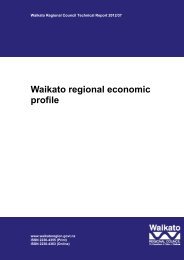Spatial distribution and seasonal variation in Undaria pinnatifida ...
Spatial distribution and seasonal variation in Undaria pinnatifida ...
Spatial distribution and seasonal variation in Undaria pinnatifida ...
You also want an ePaper? Increase the reach of your titles
YUMPU automatically turns print PDFs into web optimized ePapers that Google loves.
3. Methods3.1. <strong>Spatial</strong> <strong>distribution</strong> surveyThe start<strong>in</strong>g po<strong>in</strong>t for this survey was mussel farm structures. Mussel farm locations were identified from Waikato RegionalCouncil survey maps <strong>and</strong> although not all <strong>in</strong>dividual mussel farms could be surveyed at least one farm at each geographicgroup<strong>in</strong>g of farms was <strong>in</strong>spected. The possible spread of <strong>Undaria</strong> from mussel farm <strong>in</strong>frastructure to adjacent coastal reefsystems was exam<strong>in</strong>ed by survey<strong>in</strong>g coastal sites adjacent to every mussel farm or group of mussel farms around theCorom<strong>and</strong>el Pen<strong>in</strong>sula. Mussel farms <strong>and</strong> adjacent reef habitats were accessed from the University of Auckl<strong>and</strong> researchvessel R.V. Hawere. A comb<strong>in</strong>ation of snorkell<strong>in</strong>g <strong>and</strong> div<strong>in</strong>g observations were used as required.Other “high risk” areas for <strong>Undaria</strong> colonisation are those frequented by recreational <strong>and</strong> commercial boat traffic (Hay <strong>and</strong>Luckens, 1987; Hay, 1990, Russell et al, 2007; Verlaque, 2007). Areas with high boat traffic such as sw<strong>in</strong>g moor<strong>in</strong>g sites<strong>and</strong> boat ramps were surveyed. In-water surveys were carried out at most sites. Some shore <strong>and</strong> kayak based <strong>in</strong>spectionswere also carried out..3.1.1. Mussel farm locationsThe mussel farms around the Corom<strong>and</strong>el Pen<strong>in</strong>sula were split <strong>in</strong>to twelve survey locations. Ten locations are on thewestern side of the Pen<strong>in</strong>sula <strong>and</strong> the other two are on the eastern coastl<strong>in</strong>e at Kennedy Bay <strong>and</strong> Port Charles (Figure 1).Survey locations comprised between one <strong>and</strong> seven mussel farms, except for the Wilson Bay Mar<strong>in</strong>e Farm<strong>in</strong>g Zone(WBMFZ) <strong>in</strong> the Firth of Thames which comprises more than 150 mussel farms <strong>in</strong> 1250ha of water approximately twokilometres offshore. Operational details <strong>and</strong> site maps for the eleven smaller locations were supplied by the WaikatoRegional Council. A site map of the WBMFZ was supplied by the Sealord Mar<strong>in</strong>e Farms manager. These details wereused to contact mussel farm owners <strong>and</strong>/or operators to ensure access was approved before visit<strong>in</strong>g farms. Some farmscould not be accessed due to operational reasons. Of the 53 <strong>in</strong>dividual mussel farms listed at the eleven smaller locationsa total of 24 farms were surveyed. Seven representative farms were surveyed with<strong>in</strong> the WBMFZ.For each farm surveyed the outermost l<strong>in</strong>es at each end of the mussel farm <strong>and</strong> a selection of <strong>in</strong>ner l<strong>in</strong>es were assessed.Mussel farm size was typically ten to sixteen l<strong>in</strong>es <strong>and</strong> at least three l<strong>in</strong>es at every farm were surveyed. The numbers ofmussel l<strong>in</strong>es surveyed at each farm was generally relative to the total number <strong>and</strong> size of l<strong>in</strong>es present. However, somefarms were surveyed less thoroughly than others due to poor weather conditions <strong>and</strong> some farms did not have l<strong>in</strong>es <strong>in</strong> thewater at the time of survey<strong>in</strong>g. Farms with bare l<strong>in</strong>es were not surveyed.Surveys of l<strong>in</strong>es were conducted on snorkel <strong>and</strong>/or SCUBA. Effort was concentrated near the surface as the vertical<strong>distribution</strong> of <strong>Undaria</strong> has been found to be mostly at the surface layers on artificial structures such as mar<strong>in</strong>e farms(Chen, 2012; Duder, 2009; Hay <strong>and</strong> Luckens, 1987; Hay <strong>and</strong> Villouta, 1993; Jessop, 2006). At each farm surveyors swamthe length of each designated mussel l<strong>in</strong>e, on or near the surface, not<strong>in</strong>g the presence <strong>and</strong> density of <strong>Undaria</strong> per fiftymetre length of mussel l<strong>in</strong>e. Most mussel l<strong>in</strong>es were approximately 100m long so comprised two transects each. A total of268 transects were run along 132 mussel l<strong>in</strong>es at 31 different mussel farms. Notes were taken on the size <strong>distribution</strong> <strong>and</strong>reproductive status of the <strong>Undaria</strong> surveyed at each l<strong>in</strong>e. The presence of other <strong>in</strong>vasive species was also noted.Representative photographs were taken of <strong>Undaria</strong> <strong>and</strong>/or other <strong>in</strong>vasive species present. A m<strong>in</strong>imum of five musselswere measured on every l<strong>in</strong>e surveyed <strong>and</strong> the average mussel size was calculated for each of these l<strong>in</strong>es.Surveys of farms were carried out between November 22 nd 2011 <strong>and</strong> February 3 rd 2012. To exam<strong>in</strong>e the potential fordifferences <strong>in</strong> tim<strong>in</strong>g of surveys to <strong>in</strong>fluence the presence or <strong>in</strong>festation level of <strong>Undaria</strong> some farms were visited on bothNovember <strong>and</strong> February sampl<strong>in</strong>g trips.5
















